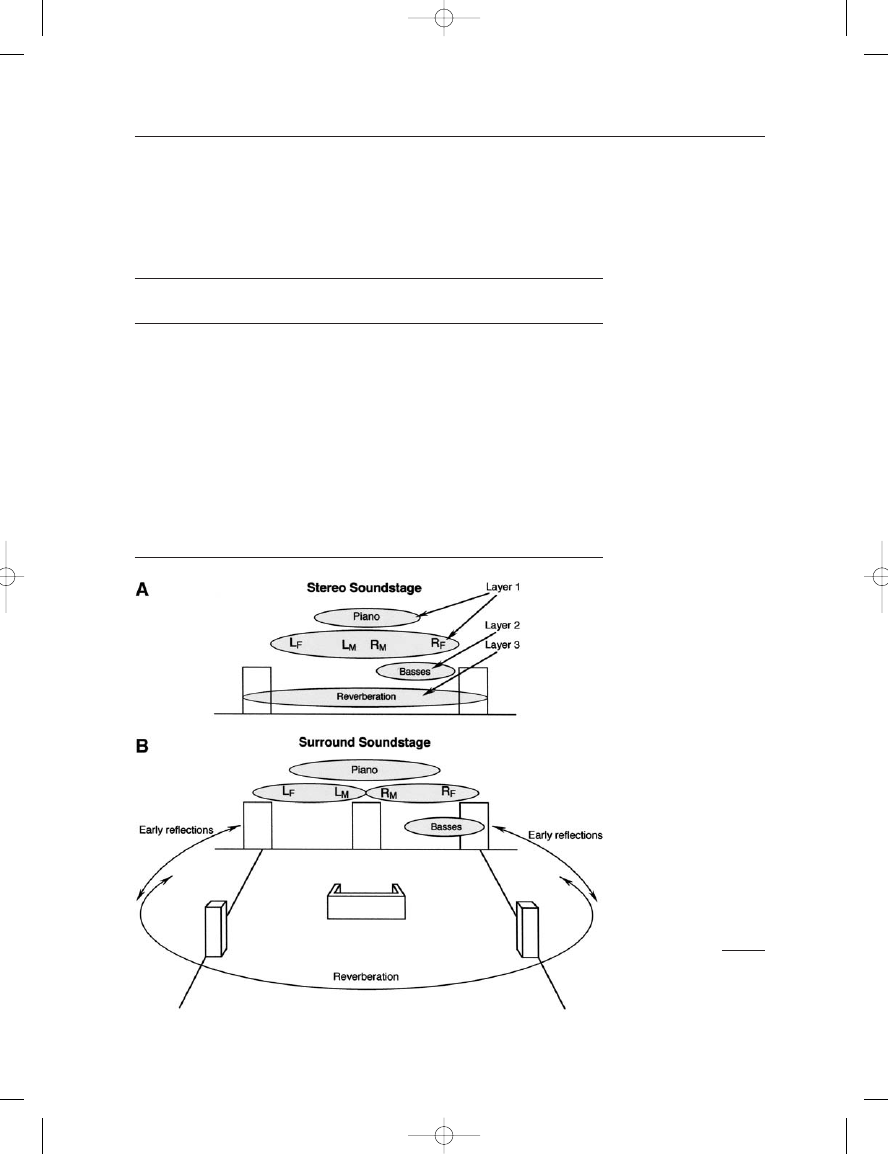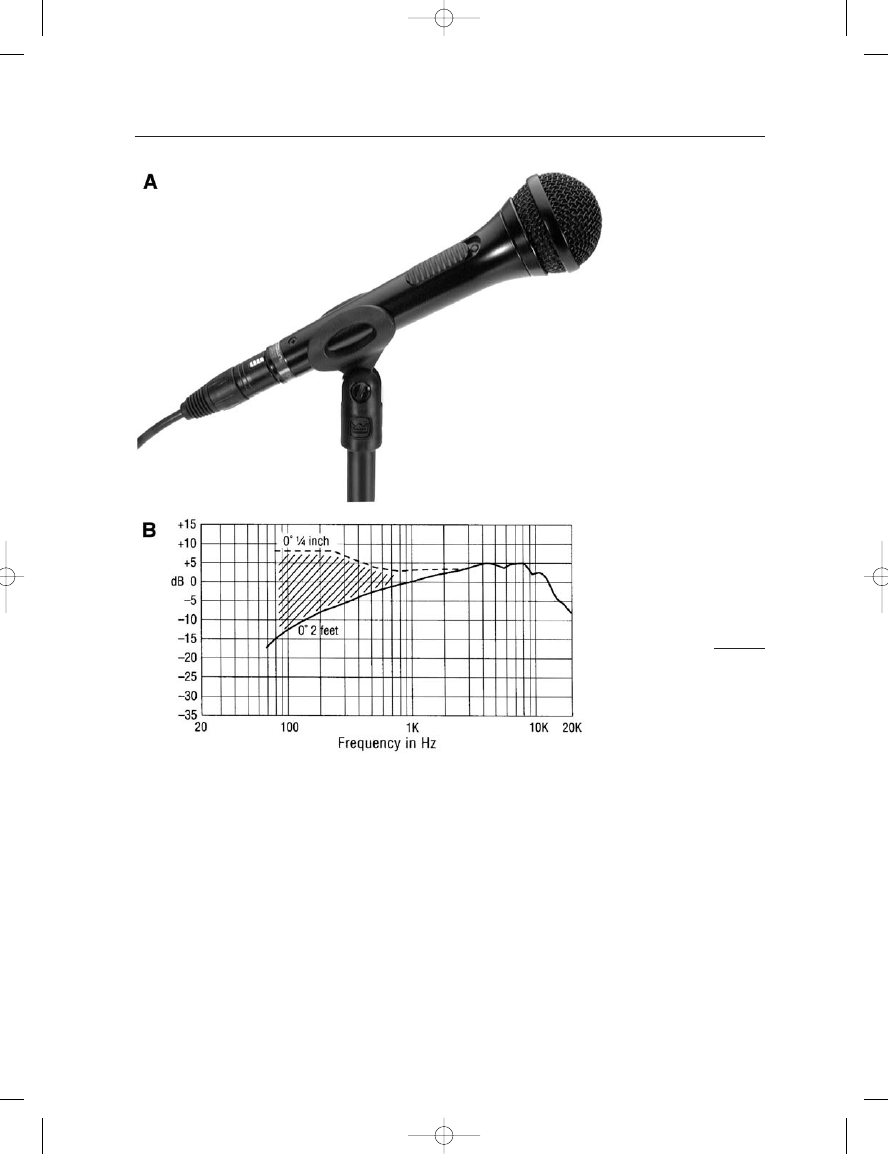ВУЗ: Казахская Национальная Академия Искусств им. Т. Жургенова
Категория: Книга
Дисциплина: Не указана
Добавлен: 03.02.2019
Просмотров: 17265
Скачиваний: 51

removed, so that it is well into the middle of the string group. Removing
the cover was a necessity for ensuring eye contact among all players.
Table 16–7 shows details of microphone and track deployment. Both
stereo and surround sound staging are shown in Figure 16–13.
THE MICROPHONE BOOK
288
TABLE 16–7
Microphone and track deployment for Schnittke Piano Concerto
Position
Description
Stereo Mic
height
Track
panning
assignment
Major components
Stereo mix left
Track 1
Stereo mix right
Track 2
Left ORTF
cardioid
left
3 m (10 ft)
Track 3
Right ORTF
cardioid
right
3 m (10 ft)
Track 4
Piano left
omni
left
2 m (80 in)
Track 5
Piano right
omni
right
2 m (80 in)
Track 6
House left
cardioid
left
3.5 m (11.5 ft)
Track 7
House right
cardioid
right
3.5 m (11.5 ft)
Track 8
These microphones appear only in the stereo mix
Main left flank
omni
left
3 m (10 ft)
Main right flank
omni
right
3 m (10 ft)
Basses
cardioid
right
1.5 m (60 in)
FIGURE 16–13
Recorded sound stages for
Schnittke Concerto: stereo
(A); surround (B).
Earg_16.qxd 14/9/04 2:59 PM Page 288

Because of fore–aft spacing limitations in the studio we introduced
an additional 20 milliseconds of delay to the house microphones in order
to “position” them as desired.
MUSICAL RECORDED REFERENCES
Hector Berlioz, “March to the Scaffold,” Symphonie Fantastique, DVD Music
Breakthrough, Delos International DV 7002, band 15.
Pyotr Tchaikowsky, 1812 Overture, DVD Spectacular, Delos International
DV 7001.
George Gershwin, Rhapsody in Blue, DVD Spectactular, Delos International DV
7002, band 12.
Hector Berlioz, Te Deum, DVD Spectacular, Delos International DV 7002, band 6.
Bizet-Schedrin, Carmen Ballet, DVD Music Breakthrough, Delos International
DV 7002, bands 3–5.
Alfred Schnittke, Piano Concerto, Delos SACD 3259 (multichannel hybrid disc).
16: Surround Recording Case Studies
289
Earg_16.qxd 14/9/04 2:59 PM Page 289

C
H
A
P
T
E
R
1
7
A SURVEY OF MICROPHONES
IN BROADCAST
AND COMMUNICATIONS
INTRODUCTION
The applications dealt with in this chapter include broadcast, news
gathering, paging in public spaces, conference management, and safety
alert systems. A number of microphone types used in these applications
have already been discussed in Chapter 10, which covers microphone
accessories. We refer to figures from that chapter where necessary as we
underscore the specific applications in this chapter.
MICROPHONE TYPES USED IN BROADCAST
AND COMMUNICATIONS
THE DESK STAND
The desk stand microphone mount is one of the oldest fixtures in
communications. It long ago disappeared from broadcast in favor of the
much more flexible pantograph assembly that allows the microphone to
be supported on a heavy, stable base with the microphone itself posi-
tioned conveniently in front of the user. The desk stand, as shown in
Figure 10–1, may still be found in a few boardrooms or paging systems,
but in the vast majority of transportation terminals the telephone handset
now takes the place of the desk stand.
THE TELEPHONE HANDSET
The telephone handset itself has undergone some important modifications.
While the older carbon button transmitter (microphone) still has some
advantages in normal telephony, it is often replaced by an electret element
Earg_17.qxd 14/9/04 3:00 PM Page 290

17: A Survey of Microphones in Broadcast and Communications
291
when the handset is to be interfaced with a paging or an announcing
system. Care should be taken to use a handset/interface which will allow
the system to mute before the handset has been placed back in its cradle,
thus avoiding the disagreeable “thunk” of hanging up.
THE NOISE-CANCELING MICROPHONE
In very noisy environments, including airplane cockpits, ship decks, and
heavy duty machinery rooms, a noise-canceling microphone is used, often
in conjunction with a hands-free headset-microphone combination. The
noise-canceling microphone is a gradient model designed for flat response
at very short working distances. Stated differently, the normal proximity
LF rise has been equalized for flat response relative to mid and HF, with
the result that distant pickup is rolled off at LF. A typical model is shown
in Figure 17–1A, and frequency response is shown at B. Close sound
sources enter primarily by way of the front opening, while distant sound
sources enter equally at front and back openings and are reduced 6 dB per
halving of frequency below about 1 kHz. In the figure, the crosshatching
shown at B indicates the effective range of noise cancellation. In order to
gain this degree of effectiveness it is essential that the microphone be posi-
tioned virtually next to the talker’s mouth. Such microphones are care-
fully designed with sufficient screening and mesh to attenuate close-in
breath sounds.
BOUNDARY LAYER (BL) MICROPHONES
Positioning microphones very close to wall or floor boundaries has long
been a general practice among knowledgeable engineers, but it was
Crown International who, during the 1970s, introduced a line of micro-
phones optimized for the purpose. These were known by the term PZM
(pressure zone microphone), indicating that these microphones responded
only to signal pressure components that were present at the boundary.
Boundary layer microphones are available from many manufacturers.
While the early models were primarily omnidirectional, modern versions
may have cardioid and hypercardioid patterns. When a directional pat-
tern is used, its axis is parallel to the boundary layer and the microphone
senses pressure gradient components that are parallel to the boundary.
The BL microphone is often placed on a large room boundary or in the
center of a large baffle, and when mounted in this manner the BL micro-
phone picks up sound with a minimum of reflections. These microphones
are ideal for placement on boardroom tables and altars, and have found
a permanent home on-stage in legitimate theaters and concert halls. A
typical omnidirectional model is shown in Figure 17–2A.
When placed on a supporting baffle, the larger the baffle the better the
LF response, as shown in Figure 17–2B. When the baffle diameter is large
with respect to wavelength, the microphone takes advantage of pressure
doubling at the boundary surface. At progressively lower frequencies
Earg_17.qxd 14/9/04 3:00 PM Page 291

THE MICROPHONE BOOK
292
the boundary “unloads” and the microphone’s sensitivity drops by 6 dB
as it approaches a free-space operating condition.
MICROPHONE GATING
For many applications an automatic microphone mixing and gating
system is used to limit the number of open microphones only to those
actually in use. (We discuss the electronic requirements for this in a later
section.) While conventional microphones are used in most of these
systems, Shure Incorporated has devised a mixing system in which the
microphones themselves can make a distinction in sound direction.
Figure 17–3 shows details of the Shure AMS26 microphone, which has
FIGURE 17–1
Photo of a noise-canceling
microphone (A); response
of the microphone to near
and far sound sources (B).
(Data courtesy of Crown
International.)
Earg_17.qxd 14/9/04 3:00 PM Page 292